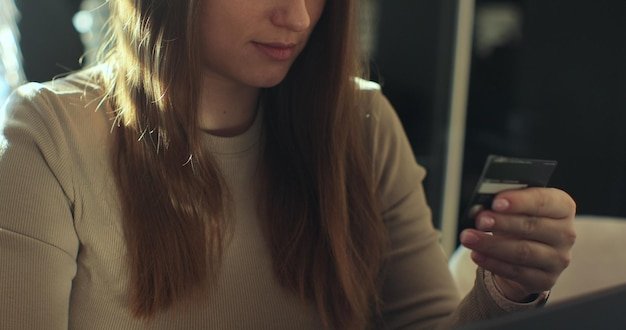Shopping addiction awareness is crucial for promoting responsible consumption habits in the US, focusing on recognizing the signs, understanding the implications, and developing healthier ways to manage the urge to splurge.
Do you ever find yourself buying things you don’t need, even when you’re on a tight budget? You’re not alone. Let’s dive into **shopping addiction awareness: responsible hauling in the US**, and how to navigate the world of retail therapy responsibly.
Understanding Shopping Addiction
Shopping addiction, also known as compulsive buying disorder (CBD), is a behavioral addiction characterized by an excessive preoccupation with shopping and buying, often leading to significant distress or impairment. Recognizing the signs is the first step towards addressing the issue and promoting healthier habits.
What is Shopping Addiction?
Shopping addiction is more than just enjoying a good bargain; it’s an uncontrollable urge to shop, regardless of financial status or need. It often serves as a coping mechanism for underlying emotional issues, leading to a cycle of guilt and regret.
Signs and Symptoms
Identifying the signs of shopping addiction is crucial for early intervention. Common symptoms include frequent and impulsive purchases, hiding purchases from family and friends, feeling guilt or shame after shopping, and experiencing financial difficulties due to overspending.
- Frequent Overspending: Regularly exceeding your budget on non-essential items.
- Hiding Purchases: Secretly buying items and concealing them from loved ones due to shame or guilt.
- Emotional Dependence: Using shopping as a way to cope with stress, anxiety, or depression.
- Financial Issues: Accumulating debt or facing financial instability due to excessive spending.
Shopping addiction can have significant consequences, affecting not only an individual’s finances but also their relationships, mental health, and overall quality of life. It’s important to differentiate between occasional impulse buys and a persistent, uncontrollable pattern of excessive shopping.

The Psychological Roots of Compulsive Buying
Why do some people develop shopping addictions while others shop responsibly? The answer lies in understanding the psychological factors that contribute to compulsive buying, often linked to emotional needs and underlying mental health issues.
Emotional Triggers
Shopping can become an addictive behavior when it’s used as a way to self-soothe or escape from negative emotions. Stress, boredom, loneliness, and sadness can all trigger the urge to shop impulsively, providing a temporary sense of relief or excitement.
Dopamine and the Reward System
The act of shopping releases dopamine, a neurotransmitter associated with pleasure and reward. This creates a positive feedback loop, reinforcing the behavior and making it harder to resist the urge to shop, even when it leads to negative consequences.
- Stress Relief: Shopping provides a temporary distraction from stressors.
- Mood Boost: The anticipation and excitement of buying something new can elevate mood.
- Sense of Control: Shopping can create a sense of control in other areas lacking in stability.
- Instant Gratification: Immediate pleasure obtained from shopping.
Addressing the psychological roots of compulsive buying often involves therapy, counseling, and lifestyle changes that help individuals develop healthier coping mechanisms. Recognizing the underlying emotional needs and triggers is a critical step in breaking the cycle of addiction.
The Impact on Finances and Relationships
The consequences of shopping addiction extend far beyond empty closets and crowded shelves. It can wreak havoc on an individual’s financial stability and personal relationships, creating a ripple effect of stress and discord. Understanding these impacts is essential for recognizing the severity of the problem and seeking help.
Financial Strain
Excessive spending can lead to mounting debt, missed payments, and even bankruptcy. As financial problems escalate, individuals may experience increased stress, anxiety, and depression, exacerbating the underlying emotional issues that fuel the addiction.
Relationship Issues
Shopping addiction can strain relationships with family and friends, particularly when it leads to dishonesty, secrecy, and financial instability. Partners may feel burdened by the financial strain, leading to arguments, resentment, and even separation or divorce.
- Debt Accumulation: High balances on credit cards and personal loans.
- Secret Spending: Hiding purchases and financial transactions from loved ones.
- Trust Erosion: Loss of faith in one’s partner due to financial deception.
- Increased Conflict: Frequent arguments about money and spending habits.
Addressing the financial and relational fallout of shopping addiction often requires a multi-faceted approach, including financial counseling, couples therapy, and individual therapy. Building a supportive network and developing open communication can help individuals repair damaged relationships and rebuild trust.

Strategies for Responsible Shopping
Breaking free from shopping addiction and developing healthier spending habits is possible with the right strategies and support. Implementing practical techniques like budgeting, setting limits, and seeking therapy can empower individuals to regain control over their finances and well-being.
Budgeting and Financial Planning
Creating a realistic budget and sticking to it is a crucial step in managing overspending. Track your income and expenses, identify areas where you can cut back, and set clear financial goals. Consider using budgeting apps or working with a financial advisor to develop a comprehensive plan.
Setting Limits and Boundaries
Establish limits on how much you can spend each month and stick to those limits. Avoid temptation by staying away from shopping malls, unsubscribing from promotional emails, and deleting shopping apps from your phone. Setting boundaries can help you resist the urge to shop impulsively.
- Create a Budget: Track spending habits and allocate funds wisely.
- Unsubscribe from Emails: Reduce exposure to promotional offers.
- Avoid Shopping Triggers: Identify and avoid places or situations that trigger the urge to shop.
- Use Cash: Limit credit card usage for better spending control.
Responsible shopping is a journey, not a destination. Be patient with yourself as you learn to navigate the world of retail therapy in a healthier way. Celebrate your successes and learn from your setbacks, and remember that it’s okay to ask for help when you need it.
Seeking Professional Help
Sometimes, overcoming shopping addiction requires professional help. Therapy, counseling, and support groups can provide individuals with the tools and strategies they need to address the underlying issues that fuel their compulsive buying and develop healthier coping mechanisms.
Therapy and Counseling
Cognitive Behavioral Therapy (CBT) is a common therapeutic approach used to treat shopping addiction. CBT helps individuals identify and change negative thought patterns and behaviors that contribute to their compulsive buying. Therapy can also help individuals address underlying emotional issues, such as depression, anxiety, or trauma.
Support Groups
Joining a support group, such as Debtors Anonymous or Shopaholics Anonymous, can provide individuals with a safe and supportive environment to share their experiences, learn from others, and receive encouragement. Support groups offer a sense of community and accountability, which can be invaluable on the road to recovery.
- Cognitive Behavioral Therapy (CBT): Identify and change negative thought patterns.
- Debtors Anonymous: A support group for compulsive debtors.
- Shopaholics Anonymous: A support group for individuals struggling with shopping addiction.
- Family Therapy: Address relationship issues related to shopping addiction.
Seeking professional help is a sign of strength, not weakness. It demonstrates a commitment to personal growth and a willingness to address underlying issues that may be contributing to shopping addiction. With the right support, individuals can break free from the cycle of compulsive buying and live happier, healthier lives.
Preventative Measures and Education
Preventing shopping addiction starts with education and awareness. By understanding the risks and triggers associated with compulsive buying, individuals can take proactive steps to protect themselves and their loved ones.
Promoting Financial Literacy
Financial literacy is a critical component of responsible spending. Educate yourself about budgeting, saving, investing, and debt management. The more you understand about personal finance, the better equipped you’ll be to make informed financial decisions and avoid the pitfalls of overspending.
Raising Awareness
Increase awareness about shopping addiction by sharing information with friends, family, and colleagues. Talk openly about the risks and consequences of compulsive buying, and encourage others to seek help if they are struggling with this issue. By raising awareness, we can break the stigma surrounding shopping addiction and create a more supportive environment for those who need help.
- Financial Education: Learn about budgeting, saving, and debt management.
- Early Intervention: Identify and address signs of compulsive buying early on.
- Family Discussions: Talk openly about money and spending habits within the family.
- Media Literacy: Critically evaluate advertisements and marketing tactics.
By investing in education, awareness, and early intervention, we can promote responsible spending habits and prevent the devastating consequences of shopping addiction. Together, we can create a culture that values financial well-being and supports those who are struggling with compulsive buying.
| Key Point | Brief Description |
|---|---|
| 🛍️ Recognizing the Signs | Identifying symptoms like frequent overspending and hiding purchases. |
| 🧠 Psychological Roots | Understanding emotional triggers and the brain’s reward system. |
| 💸 Financial Impact | Addressing debt accumulation and financial strain. |
| 🤝 Seeking Help | Exploring therapy, support groups, and professional guidance. |
Frequently Asked Questions
▼
▼
▼
▼
▼
Conclusion
Understanding and addressing **shopping addiction** is vital for promoting responsible hauling in the US. By recognizing the signs, seeking professional help, and implementing preventive measures, individuals can regain control over their spending habits and improve their overall well-being, fostering healthier relationships with money and consumption.